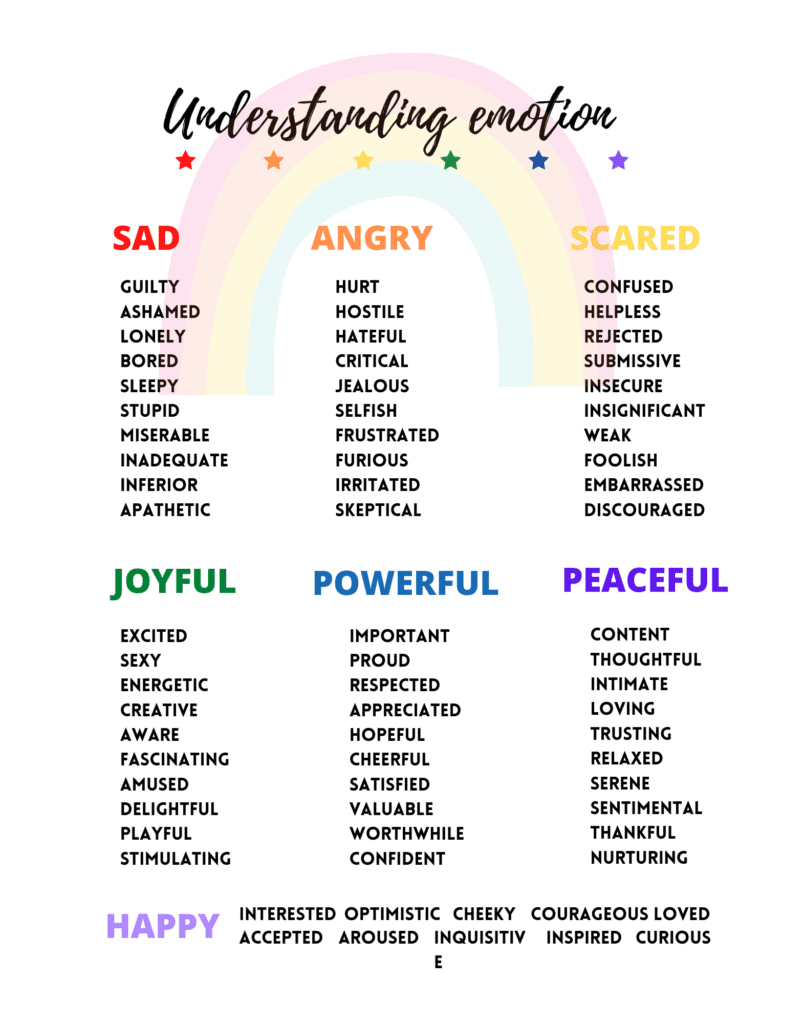
By: Annalise Maull
Getting Comfortable With Feeling My Emotions
How do you feel about your feelings? Pretty meta question, but bear with me. Do you tend to bottle up your emotions until you ultimately explode? Do you ever disregard your feelings? You may wonder, “Do we even need emotions?” The answer is YES!
Emotions make us human. They create a relationship with ourselves and others, keep us out of danger, and help us make decisions. Often, especially with social media, people believe they must present themselves as happy all of the time. There’s no way we can be perfectly happy! Life happens. We need all of our emotions to get through it.
Think of the Disney movie Inside Out. Each emotion plays a very important role, and they are all equally important in Riley’s memories! As with many other ideas, emotions can fall on a spectrum depending on severity, situation, proximity, and more, meaning emotions can look or feel different in different scenarios. Let’s focus on the basics.
Primary and Secondary Emotions
Emotions can be tricky! Let’s break it down. Emotions are defined as “a conscious mental reaction (such as anger or fear) subjectively experienced as strong feeling usually directed toward a specific object and typically accompanied by physiological and behavioral changes in the body.” Essentially, emotions are your own reaction to how you perceive something.
We have two types of emotions: Primary and Secondary. Primary emotions are an emotion based on an external event. These are usually basic emotions like mad, sad, happy, scared, and peaceful. Primary emotions can also be much more vulnerable and difficult to see. Secondary emotions are how we feel about the feeling itself. This is what we tend to see when someone expresses an emotion.
For example, your roommate didn’t clean their dishes again. The primary feeling is likely mad. Maybe anger isn’t something you’re used to feeling, or it was considered “wrong” to be mad at others. So the secondary feeling may be irritated that you feel angry in the first place leading to even more frustration with your roommate. Breaking down emotions contributes to feeling more comfortable with them and, in turn, being able to self-regulate them. Emotion regulation allows us to effectively show up in our lives even when some level of crisis occurs.
How Do We Start to Feel Our Feelings?
- Name them. Start with the big emotions that are more easily recognizable, then begin to notice what you feel when emotions are at a lower level. A feelings wheel can help if you struggle with noticing these emotions. Also, let’s stop classifying emotions as “positive” or “negative”! This creates a dichotomy, and we want to get away from “Black and White” thinking. Feelings are feelings, and we need them all.
- Let them take up space rather than push them away. While you’re in the process of getting comfy with emotions, know that you don’t need to fix anything or act on these feelings. Just notice them and what they feel like. When you acknowledge these emotions, they can go away! (Think of a toddler trying to get their parent’s attention — they don’t go away until they get what they need.)
- Learn what they want and need from you and your environment. Maybe your emotions are suggesting that you need to create a boundary, to stop seeing that toxic friend, or to spend more time on self-care. Sit with the feeling and see when it’s able to be released, or what heightens it.
- Release the judgment. Emotions happen no matter what. They become healthier to be in relationship with when you’re able to offer yourself some compassion and a non-judgmental stance. For example: “It makes sense I’m feeling irritated when I’m sitting in traffic, causing me to be late. I’m usually early, but this is okay since I can’t control the traffic.”
- Track your moods and the situations they occur in. Do you notice any patterns or triggers? Tracking moods is also a great way to help intentionally identify emotions too.
- Journal it out. Get the jumbled thoughts and feelings out of your head and onto paper! The journal linked here is a great way to observe and track your thoughts and emotions around various topics.
As you go about your day, take periodic breaks to check in with yourself and ask, “How am I really feeling?” No BS, no judgment, just examine where you’re at in that moment and listen to what you need. Your future (emotionally intelligent) self will thank you for it!

Annalise Maull is a Marriage and Family Therapist who specializes in anxiety, life transitions, and self-esteem. She is currently seeing clients in Pennsylvania and New Jersey. Annalise is passionate about making therapy and mental health topics relatable and approachable.



